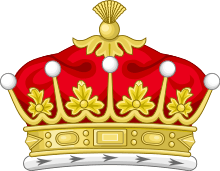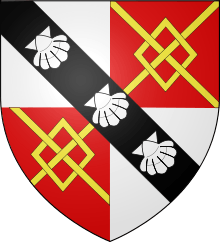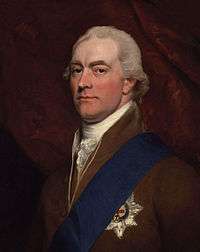George Spencer, 2nd Earl Spencer
| The Right Honourable The Earl Spencer KG PC DL FRS FSA | |
|---|---|
|
Lord Spencer by John Singleton Copley, 1800. | |
| Home Secretary | |
|
In office 5 February 1806 – 25 March 1807 | |
| Monarch | George III |
| Prime Minister | The Lord Grenville |
| Preceded by | The Lord Hawkesbury |
| Succeeded by | The Lord Hawkesbury |
| Personal details | |
| Born |
1 September 1758 Wimbledon Park, London |
| Died |
10 November 1834 (aged 76) Althorp, Northamptonshire |
| Nationality | British |
| Political party | Whig |
| Spouse(s) |
Lady Lavinia Bingham (1762-1831) |
| Alma mater | Trinity College, Cambridge |
George John Spencer, 2nd Earl Spencer KG PC DL FRS FSA (1 September 1758 – 10 November 1834), styled Viscount Althorp from 1765 to 1783, was a British Whig politician. He notably served as Home Secretary from 1806 to 1807 in the Ministry of All the Talents.
Background and education

Lord Spencer was born at Wimbledon Park, London, the son of John Spencer, 1st Earl Spencer, and his wife Margaret Georgiana Poyntz, daughter of Stephen Poyntz, and was baptised there on 16 October 1758. His godparents were King George II, the Earl Cowper (his grandmother's second husband) and his great-aunt the Dowager Viscountess Bateman. His sister Lady Georgiana married the Duke of Devonshire and became a famed Whig hostess. He was educated at Harrow School from 1770 to 1775 and he won the school's Silver Arrow (an archery prize) in 1771. He then attended Trinity College, Cambridge, from 1776 to 1778 and graduated with a Master of Arts.[1] He acceded to the earldom upon the death of his father in 1783.[2]
Political career
Lord Spencer was Whig Member of Parliament for Northampton from 1780 to 1782 and Whig MP for Surrey from 1782 to 1783. He was sworn of the Privy Council in 1794 and served under William Pitt the Younger as Lord Privy Seal in 1794 and as First Lord of the Admiralty from 1794 to 1801. He was later Home Secretary from 1806 to 1807 under Lord Grenville in the Ministry of All the Talents.
Other public positions
Lord Spencer was also High Steward of St Albans from 1783 to 1807, Mayor of St Albans in 1790, President of the Royal Institution from 1813 to 1825 and Commissioner of the Public Records in 1831. He became a Fellow of the Royal Society in 1780[3] and a Fellow of the Society of Antiquaries of London in 1785.[3] He was appointed to the Order of the Garter in 1799.[3] On 18 February 1793, he was appointed a deputy lieutenant of Northamptonshire.[4]
Book collecting
Spencer was noted for his interest in literature and particularly in early examples of printing. He was the instigator and first President of the Roxburghe Club (an exclusive bibliophilic club), founded in 1812. When Napoleon instigated the secularization of religious houses in south Germany, Spencer used local British agent and Benedictine monk, Alexander Horn, to acquire many of their rare books and manuscripts.[5]
His collection of tens of thousands of volumes was put up for sale in 1892 and acquired by Enriqueta Rylands for the John Rylands Library[6] and it was indexed by Alice Margaret Cooke.[7]
Family

Lord Spencer married Lady Lavinia Bingham (1762–1831), daughter of Charles Bingham, 1st Earl of Lucan, on 6 March 1781.[2] They had nine children:
- John Charles Spencer, 3rd Earl Spencer (1782–1845)
- Lady Sarah Spencer (1787–1870), married William Lyttelton, 3rd Baron Lyttelton, and had issue.
- Hon. Richard Spencer (1789–1791), died in infancy.
- Captain Hon. Sir Robert Cavendish Spencer (1791–1830), died unmarried in Malta.
- Hon. William Spencer (b. & d. 1792), died in infancy.
- Lady Harriet Spencer (b. & d. 1793), died in infancy.
_by_Henry_Pierce_Bone.jpg)
- Lady Georgiana Charlotte Spencer (1794–1823), married Lord George Quin, son of Thomas Taylour, 1st Marquess of Headfort, and had issue.
- Vice-Admiral Frederick Spencer, 4th Earl Spencer (1798–1857)
- The Very Reverend Hon. George Spencer (later known as Father Ignatius Spencer (1799–1864), died unmarried.
Lady Spencer died in June 1831, aged 68. Lord Spencer survived her by three years and died in November 1834, aged 76, at Althorp, and was buried in the nearby village of Great Brington on 19 November of that year.
Spencer jacket
The Spencer, a type of short jacket from which the UK military mess jacket is derived, is named for George Spencer,[8] reportedly because he had a tail-coat adapted after its tails were burned by coals from a fire.[9]
Styles of address and coat of arms
Styles of address
- 1758-1761: Mr George J. Spencer
- 1761-1765: The Honourable George J. Spencer
- 1765-1780: Viscount Althorp
- 1780: Viscount Althorp FRS
- 1780-1783: Viscount Althorp FRS MP
- 1783-1785: The Right Honourable The Earl Spencer FRS
- 1785-1793: The Right Honourable The Earl Spencer FRS FSA
- 1793-1794: The Right Honourable The Earl Spencer DL FRS FSA
- 1794-1799: The Right Honourable The Earl Spencer PC DL FRS FSA
- 1799-1834: The Right Honourable The Earl Spencer KG PC DL FRS FSA
Coat of arms
  |
|
Ancestry
| Ancestors of George Spencer, 2nd Earl Spencer | ||||||||||||||||||||||||||||||||||||||||||||||||||||||||||||||||||||||||||||||||||||||||||||||||||||||||||||||||||||||||||||||||||||||||||||||||||||||||||||||||||||||||||||||||||||||||||||||||||||||||||||||||||||||||||||||||||||||||||||||||||||||||||||||||||||||||||||||||||||||||||||||||||||||||||||||||||||||||||||||||||||||||||||||||||||||||||||||||||||||||||||||||||||||||||||||||||||||||||||||||||||||||||||||||||||||||||||||||||||||||||||||||||||||||||||||||||||||||||||||||||||||||||||||||||||||||||||||||||
|---|---|---|---|---|---|---|---|---|---|---|---|---|---|---|---|---|---|---|---|---|---|---|---|---|---|---|---|---|---|---|---|---|---|---|---|---|---|---|---|---|---|---|---|---|---|---|---|---|---|---|---|---|---|---|---|---|---|---|---|---|---|---|---|---|---|---|---|---|---|---|---|---|---|---|---|---|---|---|---|---|---|---|---|---|---|---|---|---|---|---|---|---|---|---|---|---|---|---|---|---|---|---|---|---|---|---|---|---|---|---|---|---|---|---|---|---|---|---|---|---|---|---|---|---|---|---|---|---|---|---|---|---|---|---|---|---|---|---|---|---|---|---|---|---|---|---|---|---|---|---|---|---|---|---|---|---|---|---|---|---|---|---|---|---|---|---|---|---|---|---|---|---|---|---|---|---|---|---|---|---|---|---|---|---|---|---|---|---|---|---|---|---|---|---|---|---|---|---|---|---|---|---|---|---|---|---|---|---|---|---|---|---|---|---|---|---|---|---|---|---|---|---|---|---|---|---|---|---|---|---|---|---|---|---|---|---|---|---|---|---|---|---|---|---|---|---|---|---|---|---|---|---|---|---|---|---|---|---|---|---|---|---|---|---|---|---|---|---|---|---|---|---|---|---|---|---|---|---|---|---|---|---|---|---|---|---|---|---|---|---|---|---|---|---|---|---|---|---|---|---|---|---|---|---|---|---|---|---|---|---|---|---|---|---|---|---|---|---|---|---|---|---|---|---|---|---|---|---|---|---|---|---|---|---|---|---|---|---|---|---|---|---|---|---|---|---|---|---|---|---|---|---|---|---|---|---|---|---|---|---|---|---|---|---|---|---|---|---|---|---|---|---|---|---|---|---|---|---|---|---|---|---|---|---|---|---|---|---|---|---|---|---|---|---|---|---|---|---|---|---|---|---|---|---|---|---|---|---|---|---|---|---|---|---|---|---|---|---|---|---|---|---|---|---|---|---|---|---|---|---|---|---|---|---|---|---|---|---|---|---|---|---|---|---|---|---|---|---|---|---|---|---|---|---|---|---|---|---|---|---|---|---|---|---|---|---|---|---|---|---|---|---|---|---|---|---|---|---|---|---|---|---|---|---|---|---|---|---|---|---|---|---|---|---|---|---|---|---|---|---|---|---|---|---|---|---|---|---|---|---|---|---|---|---|
| ||||||||||||||||||||||||||||||||||||||||||||||||||||||||||||||||||||||||||||||||||||||||||||||||||||||||||||||||||||||||||||||||||||||||||||||||||||||||||||||||||||||||||||||||||||||||||||||||||||||||||||||||||||||||||||||||||||||||||||||||||||||||||||||||||||||||||||||||||||||||||||||||||||||||||||||||||||||||||||||||||||||||||||||||||||||||||||||||||||||||||||||||||||||||||||||||||||||||||||||||||||||||||||||||||||||||||||||||||||||||||||||||||||||||||||||||||||||||||||||||||||||||||||||||||||||||||||||||||
See also
- Spencer Gulf, Australia
References
- ↑ "Spencer, George John, Viscount Althorp (SPNR776GJ)". A Cambridge Alumni Database. University of Cambridge.
- 1 2 Burke, John (1833). A General and Heraldic Dictionary of the Peerage and Baronetage of the British Empire. London: H. Colburn and R. Bentley. p. 466.
- 1 2 3 "Page 10143". The Peerage. Retrieved 1 May 2016.
- ↑ The London Gazette: no. 13708. p. 987. 27 September 1794.
- ↑ Mark Dilworth, ‘Horn, Alexander (1762–1820)’, Oxford Dictionary of National Biography, Oxford University Press, 2004
- ↑ Lister, Anthony (1989) The Althorp Library ... its Formation and Growth. In: Bulletin of the John Rylands University Library of Manchester, vol. 71, no. 2, pp. 67-86
- ↑ Fernanda Helen Perrone, ‘Cooke, Alice Margaret (1867–1940)’, Oxford Dictionary of National Biography, Oxford University Press, 2004 accessed 26 Dec 2015
- ↑ "Spencer, n.2, 2". Oxford English Dictionary. Retrieved 2 April 2015. OED states that the jacket is named after the earl but does not suggest why.
- ↑ "George John, Second Earl Spencer". Althorp. Retrieved 2 April 2015.
External links
| Wikimedia Commons has media related to George Spencer, 2nd Earl Spencer. |
- Hansard 1803–2005: contributions in Parliament by George Spencer, 2nd Earl Spencer
- Lister, Anthony (1989) "The Althorp Library of Second Earl Spencer, now in the John Rylands University Library of Manchester: its formation and growth". (published in: Bulletin of the John Rylands University Library of Manchester; vol. 71, no. 2 (summer 1989), pp. 67–86 )
| Parliament of Great Britain | ||
|---|---|---|
| Preceded by Hon. Wilbraham Tollemache Sir George Robinson, Bt |
Member of Parliament for Northampton with George Rodney 1780–1783 |
Succeeded by George Rodney The Lord Lucan |
| Preceded by Sir Joseph Mawbey, Bt Hon. Augustus Keppel |
Member of Parliament for Surrey with Sir Joseph Mawbey, Bt 1782–1783 |
Succeeded by Sir Joseph Mawbey, Bt Sir Robert Clayton, Bt |
| Political offices | ||
| Preceded by The Marquess of Stafford |
Lord Privy Seal 1794 |
Succeeded by The Earl of Chatham |
| Preceded by The Earl of Chatham |
First Lord of the Admiralty 1794–1801 |
Succeeded by The Earl of St Vincent |
| Preceded by The Lord Hawkesbury |
Home Secretary 1806–1807 |
Succeeded by The Lord Hawkesbury |
| Peerage of Great Britain | ||
| Preceded by John Spencer |
Earl Spencer 1783–1834 |
Succeeded by John Charles Spencer |

.svg.png)